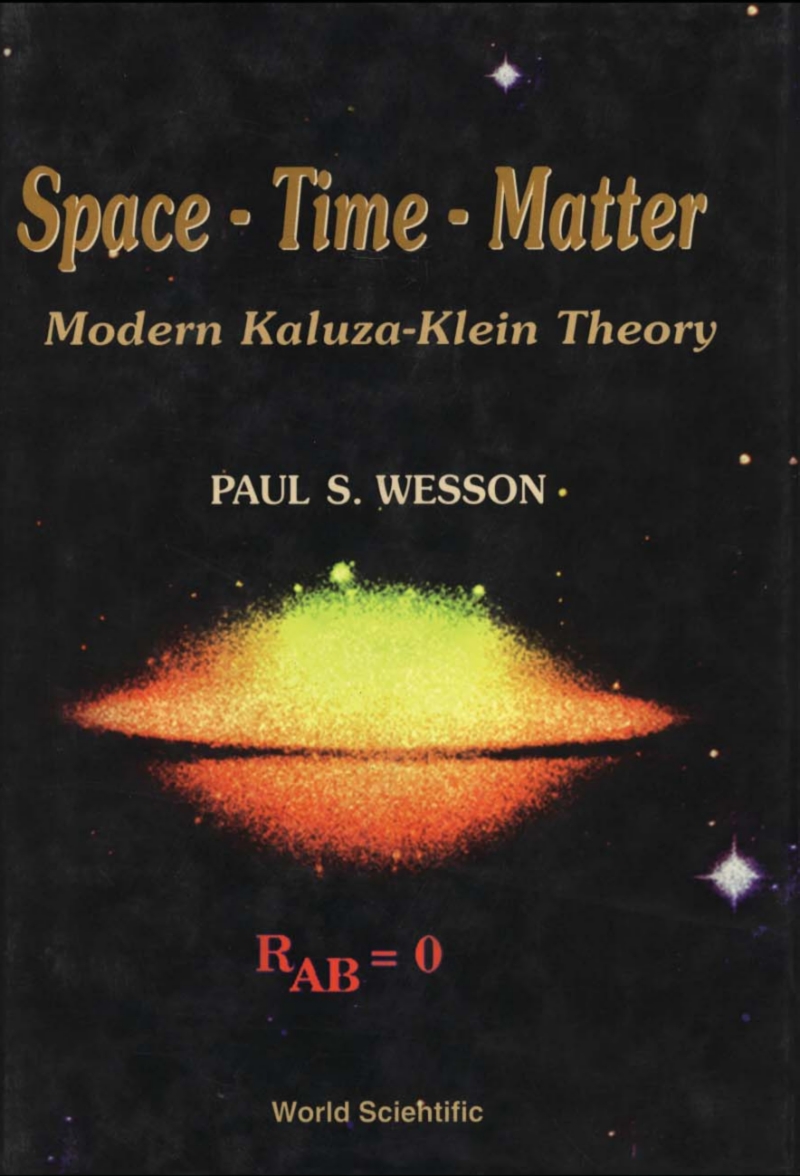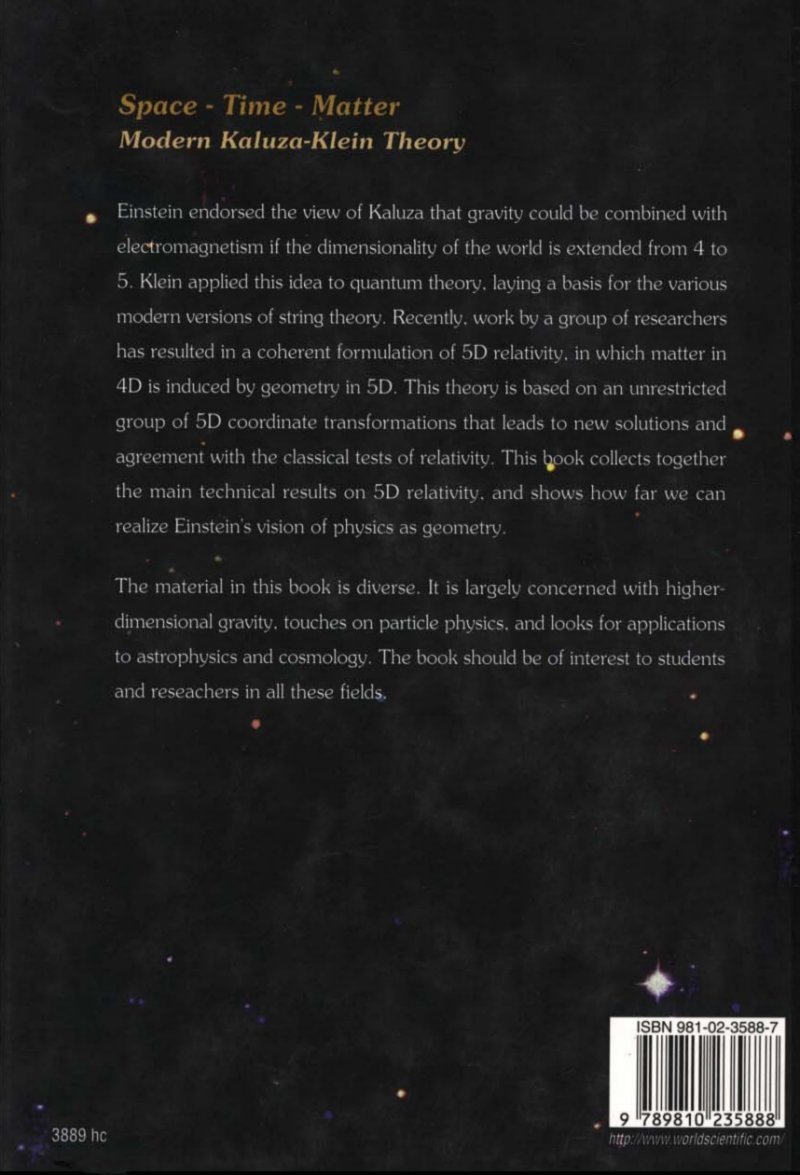
Superior Index Go to the next: Chapter 1
Print Files: A4 Size.


World Scientific Publishing Co. Re. Ltd.
P 0 Box 128, Farrer Road, Singapore 912805
USA office: Suite 1B, 1060 Main Street, River Edge, NJ 07661
UK office: 57 Shelton Street, Covent Garden, London WC2H 9HE
British Library Cataloguing-in-Publication Data
A catalogue record for this book is available from the British Library.
SPACE, TIME, MATTER: MODERN KALUZA-KLEIN THEORY
Copyright © 1999 by World Scientific Publishing Co. Pte. Ltd.
All rights reserved. This book, or parts thereof, may not be reproduced in anyform or by any means, electronic or mechanical, includingphotocopying, recording or any informationstorage and retrieval system now known or to be invented, without written permission from the Publisher.
For photocopying of material in this volume, please pay a copying fee through the Copyright Clearance Center, Inc., 222 Rosewood Drive, Danvers, MA 01923, USA. In this case permission to photocopy is not required from the publisher.
Einstein endorsed the view of Kaluza, that gravity could be combined with electromagnetism if the dimensionality of the world is extended from 4 to 5. Klein applied this idea to quantum theory, laying a basis for the various modern versions of string theory. Recently, work by a group of researchers has resulted in a coherent formulation of 5D relativity, in which matter in 4D is induced by geometry in 5D. This theory is based on an unrestricted group of 5D coordinate transformations that leads to new solutions and agreement with the classical tests of relativity. This book collects together the main technical results on 5D relativity, and shows how far we can realize Einstein's vision of physics as geometry.
Space, time and matter are physical concepts, with a long but somewhat subjective history. Tensor calculus and differential geometry are highly developed mathematical formalisms. Any theory which joins physics and algebra is perforce open to discussions about interpretation, and the one presented in this book leads to new issues concerning the nature of matter. The present theory should not strictly speaking be called Kaluza-Klein: KK theory relies on conditions of cylindricity and compactification which are now removed. The theory should also, while close to it in some ways, not be confused with general relativity: GR theory has an explicit energy-momentum tensor for matter while now there is none. What we call matter in 4D spacetime is the manifestation of the fifth dimension, hence the phrase induced-matter theory sometimes used in the literature. However, there is nothing sacrosanct about 5D. The field equations take the same form in ND, and N is to be chosen with a view to physics. Thus, superstrings (10D) and supergravity (11D) are valid constructs. However, practical physical applications are expected to be forthcoming only if there is physical understanding of the nature of the extra dimensions and the extra coordinates. In this regard, space-time-matter theory is uniquely fortunate. This because (unrestricted) 5D Riemannian geometry turns out to be just algebraically rich enough to unify gravity and electromagnetism with their sources of mass and charge. In other words, it is a Machian theory of mechanics.
There is now a large and rapidly growing literature on this theory, and the author is aware that what follows is more like a textbook on basics than a review of recent discoveries. It should also be stated that much of what follows is the result of a group effort over time. Thus credit is due especially to H. Liu, B. Mashhoon and J. Ponce de Leon for their solid theoretical work; to C.W.F. Everitt who sagely kept us in contact with experiment; and to A. Billyard, D. Kalligas, J.M. Overduin and W. Sajko, who as graduate students cheerfully tackled problems that would have made their older colleagues blink. Thanks also go to S. Chatterjee, A. Coley, T. Fukui and R. Tavakol for valuable contributions. However, the responsibility for any errors or omissions rests with the author.
The material in this book is diverse. It is largely concerned with higher-dimensional gravity, touches particle physics, and looks for application to astrophysics and cosmology. Depending on their speciality, some workers may not wish to read this book from cover to cover. Therefore the material has been arranged in approximately self-contained chapters, with a bibliography at the end of each. The material does, of course, owe its foundation to Einstein. However, it will be apparent to many readers that it also owes much to the ideas of his contemporary, Eddington.
1. Concepts and Theories of Physics 1
1.6 Supergravity and Superstrings 33
2.2 A 5D Embedding for 4D Matter 43
2.5 The Case of Neutral Matter 58
3. The Classical and Other Tests in 5D 69
3.6 The Geodetic Effect and GP-B 82
3.7 The Equivalence Principle and STEP 85
4. Cosmology and Astrophysics in 5D 91
4.2 The Standard Cosmological Model 92
4.3 Spherically-Symmetric Astrophysical Systems 105
4.4 Waves in a de Sitter Vacuum 108
4.5 Time-Dependent Solitons 111
4.6 Systems with Axial and Cylindrical Symmetry 114
4.7 Shell-Like and Flat Systems 117
5.4 Charged Solitons and Black Holes 138
5.5 Charged Black Hole Dynamics 141
5.6 Field Equations and Induced Matter 147
6. The Canonical Metric and the Fifth Force 154
6.2 Gauges in Kaluza-Klein Theory 154
6.3 The Field Equations and the Cosmological Constant 159
6.4 The Equations of Motion and the Fifth Force 161
6.5 Comments on the Fifth Force 167
7. Canonical Solutions and Physical Quantities 176
7.2 The Canonical 1-Body Solution 177
7.3 The Canonical Inflationary Solution 179
7.4 A Spinning Object in a 5D Space 181
7.5 The Nature of Mass and Charge 186